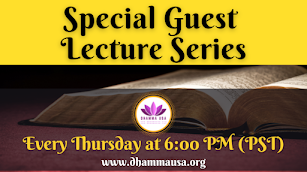Kasiṇa and Jhāna in Buddhism: From Early Teachings to Systematic Practice
By Bhante Sumitta
The relationship between kasina meditation and jhana (meditative absorption) represents one of the most significant developments in Buddhist contemplative practice. While the systematic presentation of kasina objects emerged centuries after the Buddha's time, the underlying principles of concentrated meditation on single objects form a cornerstone of the Buddha's original teachings on mental cultivation.
The Evolution of Kasiṇa Practice
The formal categorization of kasina meditation objects into a standardized list of ten represents a later systematization of Buddhist meditation practice. The explicit enumeration of the ten kasinas—earth, water, fire, air, blue, yellow, red, white, space, and consciousness—first appears comprehensively in Buddhaghosa's *Visuddhimagga* during the 5th century CE. This influential treatise codified meditation practices that had been transmitted orally and in various textual fragments for nearly a millennium.
However, the absence of this specific list in the earliest Buddhist suttas does not diminish the authenticity of the underlying meditation methodology. The Pali Canon, which preserves the earliest recorded teachings attributed to the Buddha, consistently emphasizes the cultivation of one-pointed concentration (ekaggata) through sustained attention to a single meditation object. This fundamental principle underlies all kasina practice, regardless of the specific object chosen for contemplation.
The Buddha's Approach to Concentrated Meditation
Throughout the early Buddhist texts, the Buddha's teachings on jhana development consistently emphasize the importance of establishing the mind on a fixed point of reference. Whether instructing disciples to focus on the breath (anapanasati), a visualized light, or the emergence of a mental sign (nimitta), the methodological approach remains remarkably consistent. The practitioner learns to gather the scattered energies of consciousness and direct them toward a single object with increasing stability and clarity.
This technique of object-based concentration serves as the foundation for the progressive deepening of meditative absorption. As the mind becomes increasingly unified around its chosen object, the practitioner naturally progresses through the successive jhana states, each characterized by greater refinement of consciousness and freedom from mental hindrances.
Historical and Cultural Context
The meditation techniques that would later be systematized as kasina practice did not emerge in isolation within Buddhist tradition. Archaeological and textual evidence suggests that object-based concentration methods were already established within the broader Śramaṇa movement—the diverse collection of ascetic and contemplative traditions that flourished in ancient India during the Buddha's lifetime. Even earlier Vedic meditation traditions appear to have employed similar techniques for developing mental concentration.
The Buddha's particular genius lay not in inventing these methods, but in skillfully adapting and integrating them into a comprehensive spiritual path. He recognized the psychological principles underlying object-based concentration and refined these techniques to serve the specific goals of his teaching: the elimination of suffering through the development of wisdom and the cultivation of mental freedom.
The Systematic Development
The later systematization of kasina practice into ten specific categories reflects the natural tendency of Buddhist communities to organize and preserve effective meditation techniques. This development served several important functions: it provided clear guidelines for meditation teachers, offered practitioners a range of suitable objects based on their temperaments and inclinations, and ensured the preservation of effective concentration methods across generations.
The ten kasinas encompass a comprehensive range of meditation objects that address different aspects of mental development. The four elemental kasinas (earth, water, fire, air) work with fundamental physical phenomena, while the four color kasinas (blue, yellow, red, white) engage visual perception in concentrated ways. The space kasina develops awareness of boundless extension, and the consciousness kasina cultivates recognition of awareness itself as an object of meditation.
Integration with the Noble Eightfold Path
Within the broader context of Buddhist practice, kasina meditation serves as a crucial component of Right Concentration, the eighth factor of the Noble Eightfold Path. The jhana states that emerge from successful kasina practice provide the mental foundation necessary for the development of liberating insight. These absorbed states offer temporary freedom from the mental hindrances that typically obscure clear perception, creating optimal conditions for the investigation of the three characteristics of existence: impermanence, suffering, and non-self.
Contemporary Relevance
Modern practitioners and teachers continue to find great value in kasina meditation, both as a standalone concentration practice and as preparation for insight meditation. The systematic approach preserved in later Buddhist literature provides clear methodological guidelines, while the flexibility evident in the earliest teachings allows for adaptation to contemporary circumstances and individual needs.
The relationship between kasina practice and jhana development demonstrates the organic evolution of Buddhist meditation from its foundational principles to its systematic elaboration. This development reflects not a departure from original teachings, but rather their natural maturation within communities of dedicated practitioners committed to preserving and transmitting effective methods for mental cultivation and spiritual liberation.
---
References
Bodhi, B. (2012). The Numerical Discourses of the Buddha: A Translation of the Aṅguttara Nikāya. Boston: Wisdom Publications.
Buddhaghosa, B. (1991). The Path of Purification (Visuddhimagga). Translated by Bhikkhu Nanamoli. Kandy: Buddhist Publication Society.
Gethin, R. (1998). The Foundations of Buddhism. Oxford: Oxford University Press.
Gunaratana, H. (2009). Beyond Mindfulness in Plain English: An Introductory Guide to Deeper States of Meditation. Boston: Wisdom Publications.
Rhys Davids, T.W. (1899-1921). Dialogues of the Buddha (Dīgha Nikāya). 3 volumes. London: Pali Text Society.
Thanissaro Bhikkhu. (2006). With Each & Every Breath: A Guide to Meditation. Valley Center: Metta Forest Monastery.
Walshe, M. (1987). The Long Discourses of the Buddha: A Translation of the Dīgha Nikāya. Boston: Wisdom Publications.































0 comments:
Post a Comment
Your comments and feedback are very helpful to us in improving our posts. We really appreciate your time. Thank you!
Dhamma USA Team.